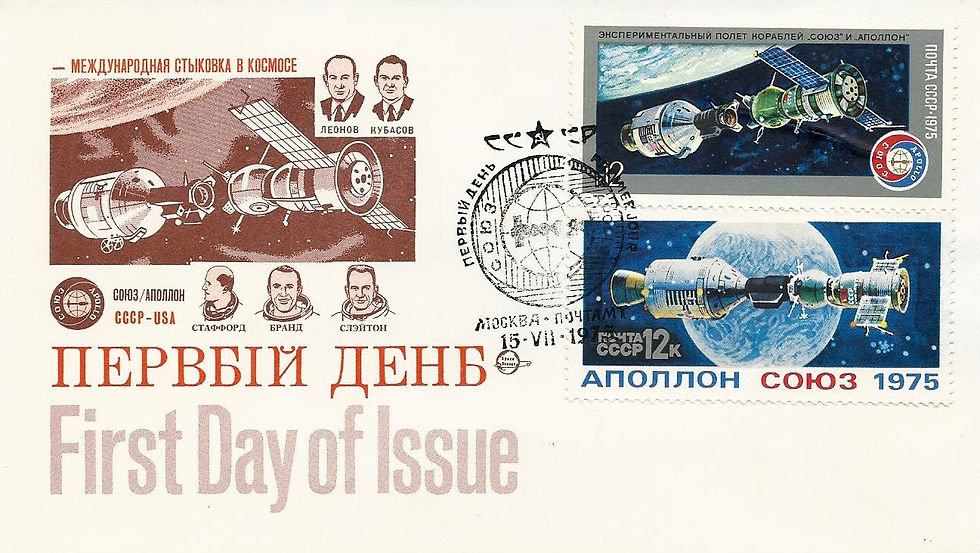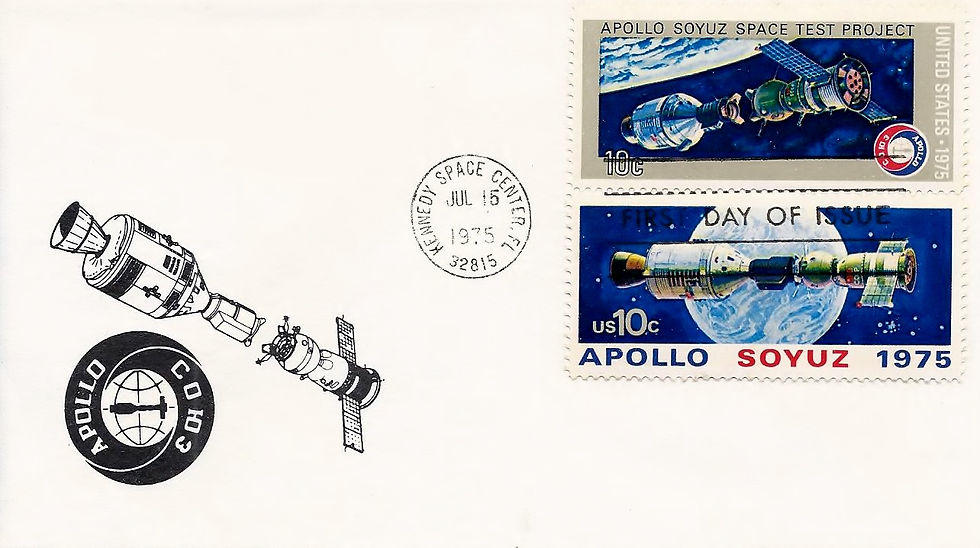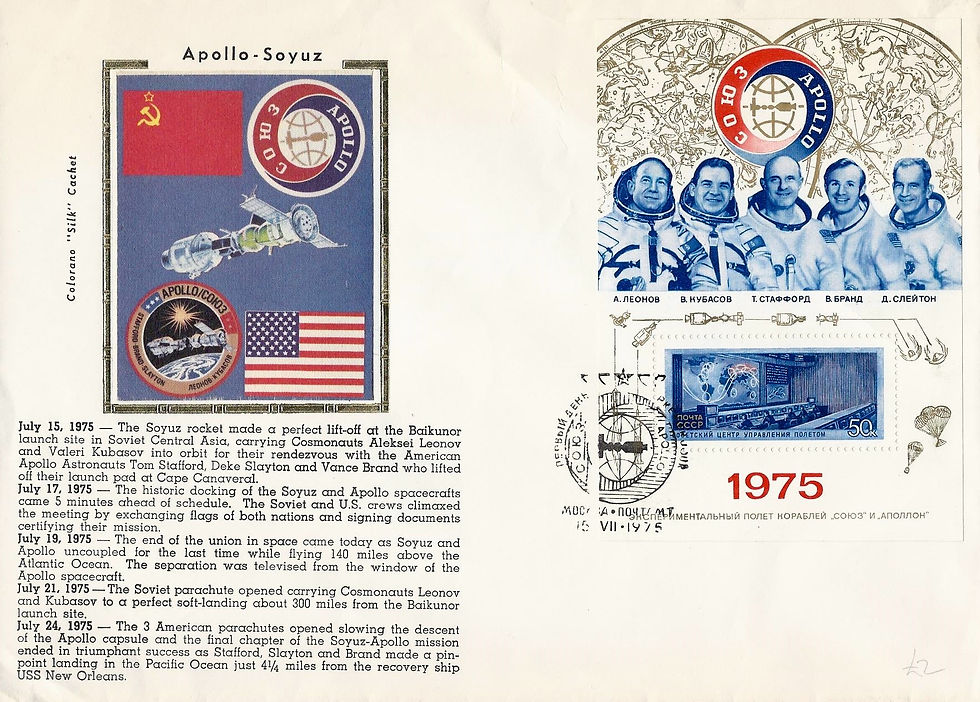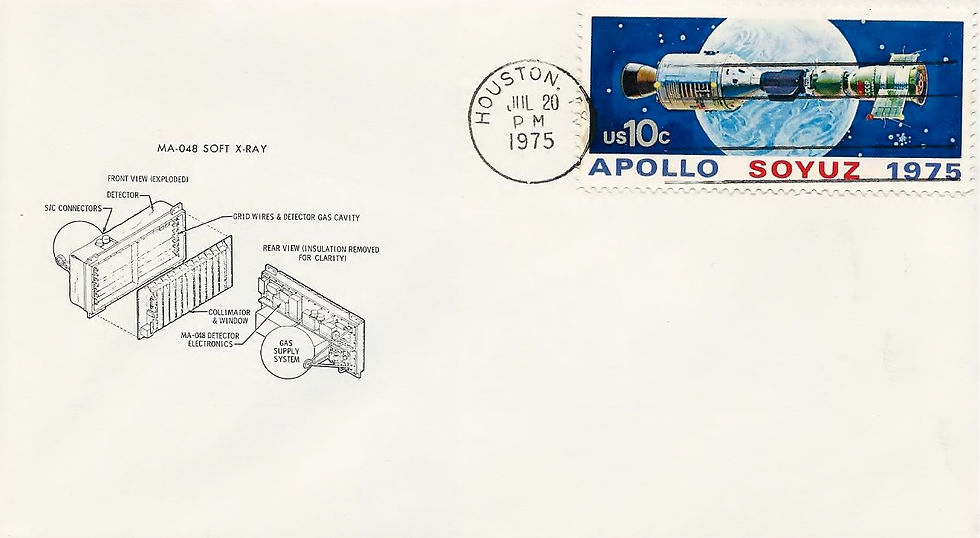
ASTP covers issued 15-24 July 1975
I will start with a small cover selection of a family company - Washington Stamp Exchange (WSE), better known under the brand of ArtCraft. The company was founded by two brothers in 1932 and produced FDCs under the brand of WSE. In 1939 a rebranding was made and ArtCraft appeared, which became the best-known American manufacturer of FDCs. Whether it is the oldest company in US FDC business - there still are disputes with Fleetwood. In 2015 the company celebrated 75th anniversary of the brand and … at the beginning of 2016, it was announced that all FDC activities are suspended. The reasons are not important to us, but what is interesting that for the ASTP, 2 types of cachets were created (emblem at the bottom and top), in three different colors - black, blue and red. All of them are very widespread - usually black cancelled at the Kennedy Space Center, the blue and red - in Moscow, but there are all sorts of variations even from abroad where the cachet served as FDC.

Moscow First Day cancellation

Moscow First Day cancellation

KSC First Day cancellation

KSC First Day cancellation

Houston, TX

JSC special cancellation

Norfolk, VA - Jul 24, 1975 Note the dark color of the cachet, missing PCS emblem and FDoI text

Houston Jul 17 Another non-typical color of the cachet minus PCS emblem and FDoI text.





Fred Karcher cachets (Frederick L. Karcher). Fred Karcher better known for his Vietnam War covers, as well as naval cachets, including Mercury splashdown. Fred began working in the early 1960s under the logo KK, later moved to his initials - FLK, and then FALKON appeared, the same we meet on Apollo-Soyuz covers. There are couple variations, most of them differ one from another by the position of the text. I really like these, especially one went through the post.


Fleetwood - probably the most famous manufacturer of the Soyuz-Apollo FDCs, at least considering the availability of covers. The company started in 1941 and successfully developed, competing with Art Craft. In 2007, Fleetwood joined Mystic Stamp Company - one of the most famous American manufacturers and distributors of philatelic products. Fleetwood brand remained alive and unharmed. I counted 7 different cachets on ASTP, cancelled mostly by First Day postmark in Moscow and Kennedy Space Center, but there are different options. The covers are indeed very common and cheap. Perhaps part - is a reprint, or maybe not. Sometimes you can find covers autographed by crews.
There are Fleetwood covers that bear blue overprint in English and Russian for the ASTP milestones and cancelled in various places in USSR on the relevant dates - I call it "Russian series". I do not know the origins but they are less common than the regular ASTP Fleetwood covers.








serviced cover with KSC link-up postmark




Not very common. 8600 of these covers were prepared to hold medals minted to honor ASTP. 4600 were cancelled at KSC and 4000 in Moscow. From the Moscow covers at least half were cut to hold a medal.

Baikonur, Jul 15, 1975 "Russian series"

Moscow International Post Office, Jul 17, 1975 "Russian series" autographed by Soyuz crew

Baikonur, Jul 19, 1975 "Russian series"

Araklyk, Jul 21, 1975 "Russian series"

Baikonur, Jul 25, 1975 "Russian series" Because of the time difference, Apollo splashdown occurred when the day changed in Moscow.

Fleetwood cachet was used as FDC
Robert Rank cachets, also known under the brands of Space Voyage, InterSpace Cover, First Rank. Generally Rank began to work in the early '60s, under the brand Texture Craft, later - Space Velvet, releasing cachets in very limited editions (35-60 pieces). After he founded Lunar Voyage brand and focused on the flights of Apollo and in 1971, after the termination of the Space Craft Covers, appears Space Voyage - it is easily distinguished by small logo on the face of the covers. On the Soyuz-Apollo ground, Rank has surpassed everybody - I counted around 70! various cachets, one way or another connected with the project. Not all of them are listed in this section – others can be found on other ASTP pages.
Most of the Space Voyage ASTP covers appear from time to time and priced at $5 or less, possible exceptions are dual cancellations and some less common cachets that can cost $10 and more.
In order to make it easer for myself and probably for the fellow collectors to trace and distinguish between different Space Voyage cachets, I decided to systematize them in the following manner:
SV - Theme - Year - Type - Variation - color
Theme makes the life easier when you know the subject of dedication like ASTP, Joint Issue or other commemoration with Apollo-Soyuz elements
Type is the major cachet
Variation is the additional minor changes to major cachet
I will elaborate on the differences between the variations. Hope this system will work, if not - I will think on something else
Note, in my system, the cancellation does not make any difference as the idea is to trace the cachets.
Sometimes the same cachets have different logos like Space Voyage and InterSpace.

SV-ASTP-1975-T3

Houston hand cancellation SV-ASTP-1975-T3

note InterSpace logo SV-ASTP-1975-T3

SV-ASTP-1975-T2

SV-ASTP-1975-T2

SV-ASTP-1975-T2 no text at the right side - the cover was prepared to have a medal



SV-ASTP-1975-T4

SV-ASTP-1975-T5-V1

SV-ASTP-1975-T5-V2

SV-ASTP-1975-T6-V1

SV-ASTP-1975-T6-V2

SV-ASTP-1975-T6-V3

SV-ASTP-1975-T7

SV-ASTP-1975-T8-V1

SV-ASTP-1975-T8-V2

SV-ASTP-1975-T9

note InterSpace logo SV-ASTP-1975-T9

SV-ASTP-1975-T9

SV-ASTP-1975-T10 Moscow International Post Office cancellation

SV-ASTP-1975-T10 Star City cancellation

SV-ASTP-1975-T11

SV-ASTP-1975-T11

SV-ASTP-1975-T12-V1

SV-ASTP-1975-T12-V1

SV-ASTP-1975-T12-V1

SV-ASTP-1975-T12-V2

SV-ASTP-1975-T12-V2

SV-ASTP-1975-T12-V3

SV-ASTP-1975-T20

SV-ASTP-1975-T13-V3

SV-ASTP-1975-T13-V1

INTE-COVER logo SV-ASTP-1975-T13-V1

SV-ASTP-1975-T13-V2

SV-ASTP-1975-T13-V2

SV-ASTP-1975-T13-V2

SV-ASTP-1975-T14 Jul 17 - Baikonur Jul 24 - Cape Canaveral

SV-ASTP-1975-T14 Jul 17 - KSC Jul 21 - Baikonur

SV-ASTP-1975-T15 Jul 17 - KSC

SV-ASTP-1975-T15 Jul 17 - Baikonur

SV-ASTP-1975-T17

SV-ASTP-1975-T17

SV-ASTP-1975-T17

SV-ASTP-1975-T16

SV-ASTP-1975-T18

SV-ASTP-1975-T19-V1

SV-ASTP-1975-T19-V2

SV-ASTP-1975-T19-V2

SV-ASTP-1975-T19-V3

SV-ASTP-1975-T19-V4

SV-ASTP-1975-T19-V4

SV-ASTP-1975-T19-V4

Carl Swanson - was a NASA artist, after that he worked in the company of Joe Fitzpatrick, Space Craft Covers – producing cachets for all sorts of space events. Space Craft cachets in general and Carl Swanson’s covers in particular have a good reputation for creativity, crafted design and print quality. After the death of Joe, in 1970, Swanson announced the end of the line and the beginning of the Space Craft production of covers dedicated only to manned missions of Apollo 13 - 17. Then came a confusion - part of the covers for the unmanned flights was published anyway, including Soviet series (1971-72). Later, Swanson created by himself, including Apollo-Soyuz covers. All of his covers bear his last name as a logo.







Space City Cover Society (SCCS).
Established by space philately enthusiasts of Houston, home of Manned Spacecraft Center (now – Johnson Space Center), previously known as Space City Philatelic Society. This organization was led by two dedicated individuals – Harry Anderson and Allen Banks. Following the deaths of Apollo 1 crew in 1967, the Society started to produce philatelic covers to commemorate space related events. Unfortunately Houston Post Office regulations declined any special postmarks, thus in the same 1967, SCCS created its own Local Post under the name – NASA Local Post (NLP). There has been no connection to NASA or any other government agency, just a nice logo. In 1972 SCCS got permission to use its own Mailer’s Postmark Permit (MPP).
In our story SCCS covered pre-flight, flight time and a bit of post-flight activities, so we can find covers with regular cancellations, MPP applied and NLP variations. I counted around 50! ASTP cachet variations and around half of them dedicated to pre-flight activities. Pre-launch and Local Post covers are covered in relevant sections. There are also some SCCS-type covers that I cannot identify 100%.
Great source of information is NLP and SCCS website.




















Frederick (Fred) Bean, Stamp Professor, cachets.










SCPS - Space Coast Philatelic Society
According to the information I have – the SCPS (or S.C.P.S.) was a private venture of a known German dealer Eberhard Coelle and has no connection to any US philatelic society. These covers appear from time to time, sometimes signed, sometimes - not, but always bearing SCPS stamped logo with numbers. The signature belongs to F.J. "Dusty" Rhodes, Postmaster of KSC Post Office to whom Coelle was pretty close at that time. The “SCPS” covers are not very expensive though not widely seen.




KSC rubber stamped cachet branded by SCPS

SCPS brand most common on the cover reverse
Here are the other flight-time ASTP commemorating covers in my inventory. Most of them are very common ASTP cachets. Frankly speaking - there is so much ASTP stuff that I really focus on the less common, sometimes forget about ordinary material.
Some notes regarding KSC official rubber stamp cachet (RSC) and ASTP docking official postmarks.
The two KSC ASTP rubber stamp cachets were ordered on May 27, 1975 and received on June 11, 1975. The cachet was applied to all covers received up to the day before launch. Particular attention was given to the limit of five per requestor. The KSC ASTP cachet was shredded on July 16, 1975. 53,529 covers received the ASTP RSC and another 26,690 covers received only the KSC cancellation (no cachet).
On July 17, 1975 a special pictorial cancel was used at KSC and Houston commemorating the linkup of Apollo and Soyuz. 235,500 covers received the KSC cancel and 103,127 covers received the Houston cancel.
info taken from collectSpace.com

ASTP rubber stamped cachet (RSC) - the most common cachet. It was applied to over 53,000 covers.

just nice stamps


First Day KSC ASTP rubber cachet with San Francisco Apollo recovery cancellation

Alan Bean Ron Evans Jack Lousma bought for $140 from a dealer










Lollini faked Baikonur postmark

San Francisco red hand cancellation



ASTP flyer commonly found in KSC covers





KSC Apollo program postmark

KSC FDOI postmark




Ross silver foil cachets.
Often available in bundles for $2-5 per cover. Some sources advise that Ross covers were produced in quantities of 500 per cachet.

Kennedy Space Center

Cape Canaveral



crew transfer





First Day of ASTP stamp issue commemorating cachet

First Day of ASTP stamp issue commemorating cachet

First Day of ASTP stamp issue commemorating cachet
Robert (Bob) McCall is THE ARTIST of American Space Program and his artworks accompanied NASA since first manned flights. In the ASTP area his involvement cannot be overestimated, just take the design of the joint USA-USSR stamp issue. Besides his ASTP cachet, he used to make a brief sketch-drawings on the covers or just pieces of paper accompanied with his autograph.
Lois Hamilton – she was one of the most creative designers of First Day Covers, mostly focusing on animals and American history. This ASTP cachet is rather uncommon to her designs.
Doris Gold - was an accomplished professional artist, and a mural artist for her own business, Murals by Doris. She always had a love of drawing and the arts. Doris had her own First Day Cover business for creation of US Postal Cachets for the Post Office for over 40 years with hundreds of collectors, nationally and internationally.
She wrote newsletters for her business. She won many awards for her postal cachets. There is a display of her cachet artwork in the Smithsonian Institution Museum. Doris won a postmark design contest in 1974 for the Museum of Science and Industry in Chicago.

this cover is mostly seen with a medal inside, I find it very uncommon to get it intact

another "medalist" cover


Robert McCall - space artist and designer, author of ASTP joint issue stamps. PSA/DNA certificate is included.

Hamilton cachet

Hamilton cachet

Doris Gold cachet

Doris Gold cachet

Doris Gold cachet

Melissa Fox hand cachet
Robert (Bob) Whitney was a dedicated serviceman who spent in the military over 30 years, retiring as Chief Master Sergeant from the US Air Force. He stayed in Cape Canaveral and devoted himself to the Space Coast commemorative activities including space cover servicing. Bob serviced covers for all events from the Eastern Test Range from roughly 1967 through the early 90's. Collectors would send him stamped envelopes and Bob would have them cancelled and would apply an appropriate cachet. He predominately used Cape Canaveral and Patrick AFB for cancels.
Bob cachets were printed and not rubber stamped as one may think. At some point his artist for many of the printings was Don Mackey, but it is hard to say whether ASTP cachets were created by him or not. Bob was connected to another dedicated cover servicer – Bob Boudwin, so many covers bear his name and address. Bob Whitney ASTP cachets are not very common, though some of them are seen more than the others, I find them very attractive not only in design, but also in being a great series (possibly the only in its kind) to cover each and every day of ASTP flight – Jul 15 – 24, 1975. Note the erroneous writing of SOYUZ word in Russian – ССЮЗ instead of СОЮЗ.
info taken from collectSpace.com




Patrick AFB cancellation note different format of Apollo 11 overprint











Patrick AFB postmark










Patrick AFB


serviced aerogramme
Astro-covers cachets.
Not very colorful but quite informative cachets. There were probably less than 250 covers produced of all issues.
Note, some of the covers bear the Astro-covers emblem, other do not.










USS New Orleans big stamp
Another well-known producer of FDCs and space event series is of cause Colorano Publishers Ltd established and originally managed by Ray Novak (the name Colorano comes from Color-Ray-Novak). He started to produce cachets in 1962 for Project Mercury stamp.
When Ray first saw the silk cachets produced by the French firm Ceres in 1970, he knew instinctively that that was the route he had to go. He felt certain that these lovely silk cachets surrounded by a delicate gold border would be well accepted by the American collector and in 1971 the famous “Colorano Silk Cachet” brand was born.
Colorano "silk" First Day Covers are among the finest being produced today. The covers are called "silk" because the cachet is made by a printing process of placing the subject matter on a pre-gummed finely woven fiber square of cloth, much like the old silk screen printing method.
Most of the space events “Colorano Silk” covers were produced by a limited numbers of 5000 and less unlike other FDC brands that are printed in hundreds of thousands. ASTP series is quite common except possibly a couple of covers that can be met on rare occasions. I have counted more than 20 variations of ASTP cachets. The cachet designer for ASTP and many other “Colorano Silk” space issues was Italian artist Tenzi who also created in Italy under the brand FDC ”Roma” - this is the reason that some series like Skylab and ASTP can be met under two different brands (actually 3 – FDC “Roma”, Colorano Silk and Philgraf).
Besides silk inventory Ray Novak tried to run a small size series of printed analogues of silk cachets under the brand Philgraf. Philgraf cachets are available for the late Apollo flights, Skylab and ASTP. It looks they were not too popular, thus the idea vanished and the series discontinued. Philgraf cachets are still widely available on the markets.
In early 2016, Colorano was purchased by Mystic Stamp Company, America's leading stamp dealer. According to the information available in the Internet – there are no plans to create new Colorano covers.
most info from knottywood-treasures.com


Moscow First Day of Issue

Soyuz launch Baikonur postmark

Apollo Launch Kennedy Space Center

Apollo Launch Cape Canaveral

Docking Houston

Docking Star City

Docking Cape Canaveral

Apollo crew visit Soyuz Cape Canaveral

Soyuz crew visit Apollo Moscow

undocking Cape Canaveral

undocking Kaluga

Soyuz landing Baikonur

Apollo Splashdown Cape Canaveral

Apollo Splashdown San Francisco

Apollo Splashdown Norfolk, VA

ASTP crew Kennedy Space Center

Moscow First Day of Issue


Soyuz crew Kennedy Space Center

Apollo crew Kennedy Space Center

Moscow First Day of Issue

Moscow First Day of Issue

Moscow First Day of Issue

Alsfeld - docking

Tom Stafford

Apollo launch Cape Canaveral

missing Philgraf logo and text

Docking Cape Canaveral

docking - KSC

Apollo crew transfer Cape Canaveral

Undocking Cape Canaveral

Apollo splashdown Cape Canaveral

Apollo launch - Tenzi artwork

ASTP dedicated cachet designed by another artist. No connection to Colorano cachets, just for the contrast.

another Tenzi cachet replicated on Colorano Silk and Philgraf covers
German (W. Anklam) cachets.
One of the most common of ASTP cachets is of cause the German series. These cachets were probably created by Wolfgang Anklam who was active in early-mid 70s producing many covers for Soviet space program. Unlike his previous cachets the ASTP covers do not have his signature hidden inside the picture but the style is very similar. Until I get any other info I will refer to these as “W. Anklam cachets”. Some of the covers have Astro Documenta inscription on the side, thus probably printed by Astro Documenta without any reference to the artist (but this only my opinion).
Back to the covers – they are widely available indeed for $4-5 or less if bought in stocks. They have a variety of postmarks – Baikonur, Moscow FDOI, Moscow International Post office, Star City as well as US – Cape Canaveral, Kennedy Space Center, Houston and more. Don’t forget that German dealers specialized on getting their covers postmarked by Kniga. This is one of four ASTP cachet series that got such wide array of Soviet postmarks, the others are Fleetwood, Robert Rank and Colorano Silk.

Baikonur

Star City

Moscow International

Cape Canaveral

Jul 15 - KSC Jul 21 - Moscow International

Jul 15 - KSC Jul 24 - Cape Canaveral

Moscow FDOI

Moscow FDOI note Astro Documenta inscription on the left corner

KSC FDOI

Baikonur

Moscow International

KSC special cancellation

Moscow International

KSC special cancellation

Baikonur

Baikonur

Moscow International

KSC Apollo program

Houston

Moscow Interantional

Baikonur

Houston

KSC Apollo program
Here is another batch of assorted ASTP cachets. Most of them are widely available.



Houston Area Boy Scout Club













Gemini style JN cachet







hand painted

hand painted






Several small series – Aristocrat Cachets, Artopages, Orbit Covers and Centennial thermo cachets (the last one and the largest). Interestingly that some covers from the same series are quite common the others are not.







not a perfectly done, but still ARTOPAGES























hand-painted cachet




Dallas Health and Science museum card

Dallas Health and Science museum card




KSC club cachet










Ken Havekotte cachet


"pseudo VIP card", but still nicely crafted...


Cover Craft Cachets





































signed by Stephen Cobaugh editor of Space Age Times magazine

Therome Cachets

Therome Cachets




















Signed by Apollo surgical team







Washington DC
The presented covers have been produced by George H. Goldey (1923-1994) of Canton, Texas, under the name Goldcraft Cachets.
George Goldey was a pioneer space cover maker, but he also proved he was quite an inventor. Living in Canton, Texas, he began making first day covers for stamps being issued by the U.S. Post Office Department in the mid 1950's, and Goldey made cachets for political events happening in Texas. Goldey had his peculiarities and often made covers about subjects with the word "gold" in them too. He also became fascinated with the U.S. space program and adamantly adopted it as his own, becoming a space cover cachet maker at the dawn of the U.S.' space program in 1958.
Goldey's space cover business was a family affair. He apparently did not keep a record of how many covers and versions he made, and he made his covers with a printing press he maintained at his house. The handwriting addressing his covers was that of his wife, who lovingly helped him on his space covers, and also his children. Goldey was a great space cover contributor at the dawn of the modern space age promoting and advancing space cover collecting. We, indeed owe George Goldey and his family a tremendous debt of gratitude.
Astrophile article (Vol. 55, No.2, Issue #313) written about George Goldey by Steve Durst.
















Moscow, MI postmark